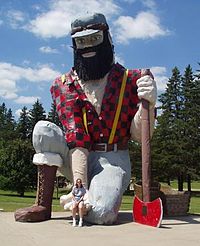Paul Bunyan
Paul Bunyan is a fictional giant lumberjack. James MacGillivray wrote about Bunyan in 1910, which is the earliest writing about Bunyan that we know about. A few years later, in 1916, William Laughead was writing an advertisement, and decided to use Bunyan in what he was writing, and decided to make him a giant.

Origin of Paul Bunyan
changeJames Stevens wrote a book called Paul Bunyan in 1925. This book said that French Canadians people made up the Paul Bunyan stories during the Papineau Rebellion of 1837, when they were fighting against England.[1] This would explain why Paul Bunyan's last name is "Bunyan", because "Bunyan" sounds like the French-Canadian slang word "Bonyenne", which is something that they might say when they are surprised, like how people who speak English might say "Good Grief" or "My Goodness". People told other people stories about Bunyan, and the stories would change a little bit as they spread from person to person. Often, Paul Bunyan is shown in pictures with a giant blue ox named Babe. Historians think that Babe was not created until the 20th century for advertising. Other theories is that the Paul Bunyan was based on the legendry "Big Joe Mufferaw" [aka French-Canadian lumberjack Joseph Montferrand [1802-1864].[2] or on a French-Canadain lumberjack in Michigan named Fabian "Joe" Fournier [1845-1875][3][4]
Legends about Paul Bunyan
changeAccording to legend, when Bunyan was born, it took three storks to carry him. (In some stories storks carry babies and drop them off at their parents' houses.). When he became older, he broke every window in the house when he clapped or laughed. When he was seven months old, he sawed the legs off his parent's bed in the middle of the night.[5] Paul and his friend, Babe the Blue Ox, dug the Grand Canyon when Paul was carrying his axe with a blade made from a locomotive and dragging it behind him. Babe, Bunyan's friend, was a large and very strong animal.[6]
Many different towns say that they are the "home" of Bunyan. Some of these towns are in Minnesota, Michigan, and Wisconsin, although there are towns in other states, too.
In the town of Kelliher, Minnesota, there is a park called Paul Bunyan Memorial Park, where there is a grave site that says that Paul Bunyan is buried there.
References
changeNotes
change- ↑ "Legends of Paul Bunyan". Archived from the original on 2008-06-28. Retrieved 2009-08-26.
- ↑ "Biography – MONTFERRAND, Favre, JOSEPH – Volume IX (1861-1870) – Dictionary of Canadian Biography". Retrieved 2017-12-23.
- ↑ L'Heureux, Juliana. "From French-Canadian to Franco-American". www.mainewriter.com. Retrieved 2017-12-23.
- ↑ MMCC. "MyBayCity.com Bay City's Roots in the Paul Bunyan Tales To Be Subject of Documentary Film". www.mybaycity.com. Retrieved 2017-12-23.
- ↑ Stoutenburg, Adrien, American Tall Tales, Puffin Books, New York, 1976
- ↑ "Babe the Blue Ox: A Minnesota Tall Tale from American Folklore". Archived from the original on 2008-12-11. Retrieved 2008-10-31.
Other websites
change- "The Story of Paul Bunyan", Paul Bunyan Trail
- Paul Bunyan: How A Terrible Timber Feller Became the Legend Archived 2012-03-09 at the Wayback Machine, History of the Paul Bunyan Legend
- Roadside statues and other tributes to the Great Tree-Biter, Paul Bunyan Archived 2014-11-28 at the Wayback Machine, Roadside America
- Animated stories of Paul Bunyan